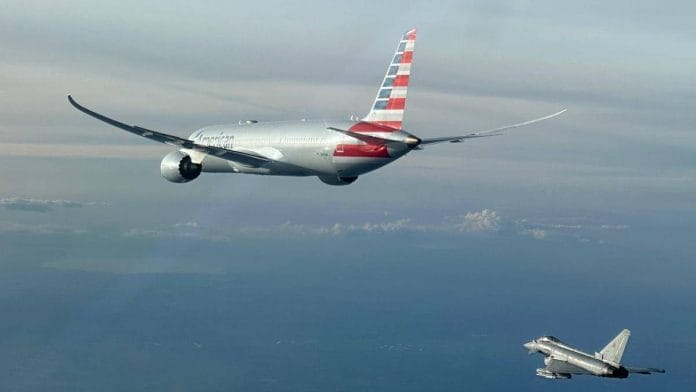New Delhi: When an American Airlines flight from New York to New Delhi received a “security threat” while it was mid-air Sunday, aviation authorities swung into action swiftly.
The Boeing plane carrying 199 passengers plus crew was reportedly over the Caspian Sea when the alert was sounded and it was decided to immediately divert the flight to Rome.
Two Eurofighter Typhoon jets from Grosseto Air Base intercepted and escorted the aircraft to Fiumicino Airport, ensuring a safe landing, where it was “inspected by law enforcement”.
Italian media reported that the diversion was caused by an “alleged bomb threat” while NBC News said that according to protocol at New Delhi’s Indira Gandhi International (IGI) Airport, an inspection was required before the plane landed there. The US Federal Aviation Administration said the crew reported the security issue.
The jet escort, while considered standard protocol during a security threat, sparked questions, such as why the flight was diverted to Rome instead of a closer airport and why one of the jets was seen flying so close to the aircraft.
?? Air Force scrambled the 23rd due to a report of a presumed explosive device aboard a commercial aircraft headed towards Delhi ?? from JFK ??
The aircraft had reversed its course to Fiumicino Airport & was identified and escorted by 2 ?? Eurofighter Typhoon#SecuringTheSkies pic.twitter.com/uPwdpIGXto
— NATO Air Command (@NATO_AIRCOM) February 25, 2025
According to emergency protocols, flight crew prioritises airports based on security considerations, emergency response capabilities, runway compatibility (particularly for larger aircraft like the B787), and operational requirements.
Rome’s Fiumicino Airport may also have been a suitable option as it is well-connected to both New York and India, serves American Airlines, and offers maintenance and rebooking facilities. The jets flew close to the airliner to conduct external inspections.
While some argue that such measures are unnecessary for threats concealed inside the cabin, authorities cannot predict the nature or intent of potential threats. Flying in close proximity allows for better monitoring of suspicious activities, particularly over populated areas, and ensures a swift response to any potential threat, such as attempts to drop explosives.
According to an article in The Aviationist, the Italian Air Force intercepted the American Airlines aircraft as part of its 24×7 national airspace surveillance, integrated with NATO’s air defence system. The Combined Air Operations Centre in Spain issued an order for the jet to take off from Grosseto under QRA (quick reaction alert). The fighters, guided by IADM (NATO Integrated Air and Missile Defence), identified and escorted the aircraft to ensure it followed its intended route.
In such operations, jets are prepared to intervene if the aircraft deviates toward sensitive areas or poses a threat, with the authority to shoot it down as a last resort.
The two Eurofighters were armed with the IRIS-T and AIM-120 AMRAAM missiles.
Regarding the safety of the Eurofighter if the B787 exploded mid-air, the jet trailing it would likely have had enough time and space to react. While some debris might have scattered toward the fighter, drag and gravity would reduce the risk, allowing it to manoeuvre away safely.
Chandan Singh is an intern with ThePrint
(Edited by Nida Fatima Siddiqui)
Also Read: Army Air Defence looks to procure surveillance systems for smallest drones, ‘smart ammunition’






